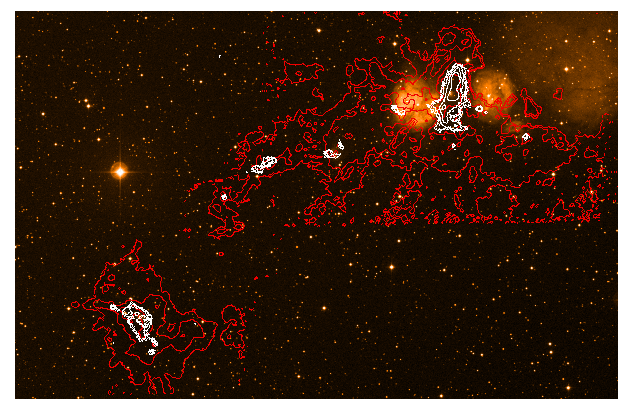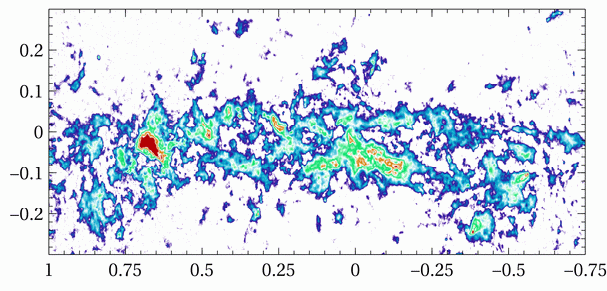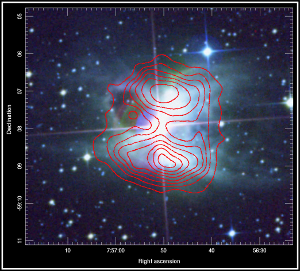The scientific staff at the JCMT are active in their own research. A brief overview of the research topics covered by our staff scientists can be found below:
Contents
Jan Wouterloot

This picture is the product of a JCMT/UKIRT Staff project, studying the Gem OB1 region with JCMT and UKIRT (in combination with other data). It shows integrated CO(3-2) emission from JCMT (red), 850μm emission (white, SCUBA-2 from JCMT) superimposed on the red DSS image. It shows the HII regions Sh2-254 to 258. There is still ongoing star formation as seen from molecular (CO(3-2)) outflows. WFCAM images from UKIRT show the young stellar clusters embedded in the dust seen in the 850μm emission as well as H2 jets and outflows.
Other projects I am involved in include
- multiwavelength studies of star forming regions at larger distances in the Outer Galaxy, WB89-436,437,997, as well as the more nearby objects CB230 and NGC6357.
- A JCMT backup project for grade 4 and 5 weather uses RxA3 and HARP to observe a large sample of carbon and other late-type stars in CO, 13CO, HCN, H13CN, and other lines. Until now more than 350 objects have been observed in one or more of these transitions. This will provide a uniform dataset for studies of these stars.
Harriet Parsons
My research is focused on understanding the early stages of Massive Star Formation. Currently my work is focused on a smaller compact but active region of massive star formation located near the Galactic Centre. I am currently undertaking a multi-wavelength study of this region.
I am an active member of the JCMT Plane Survey (JPS) and have also imaged the Galactic Centre using SCUBA-2.
Mark Rawlings
My research addresses several topics, mostly focusing on the properties of dust and gas in a range of interstellar medium environments:
The Diffuse Interstellar Bands (DIBs)
DIBs are intrinsically weak spectroscopic absorption features that are superimposed on the spectra of background stars that lie behind diffuse interstellar clouds. They are both numerous and ubiquitous in the spectra of diffuse interstellar environments, but the identification of their carrier species remains one of the longest-standing problems in astrophysics. It is now widely believed that the DIBs are attributable to hydrocarbonaceous molecules/ions in the diffuse interstellar medium, but the chemical flexibility of carbon means that specific identifications remain elusive. I have been involved in studies of these DIBs at the visual and (more recently) near infrared wavelengths, characterizing their profiles, relative strengths and relationships with other interstellar medium components in a range of environments, most notably toward sightlines exhibiting high visual extinctions (Rawlings et al. 2014 and references therein).
Molecular Clouds and Filaments
The mapping of near-infrared (NIR) scattered light is a relatively new, complementary technique for studying interstellar clouds. My colleagues and I have investigated the feasibility of this method on larger scales using the aforementioned UKIRT/WFCAM JHK TMC-1 filament imaging data (Malinen et al. 2013). The data were also converted into an optical depth map and the results compared with NIR extinction maps and Herschel observations of sub-mm dust emission. I have also been involved in comparative visual/IR studies of the various components of interstellar environments (Polycyclic Aromatic Hydrocarbons, Very Small Grains and big “classical” grains) with differing visible/UV interstellar radiation fields (Rawlings et al. 2013 and references therein). I am also co-leading an ongoing multi-wavelength study of the unusual bipolar reflection nebula system IC 2220 (the Toby Jug Nebula), a co-investigator in ongoing ALMA studies of CO in Asymptotic Giant Branch stars in the Magellanic Clouds, star formation in Bok Globules and various other related projects. I am consequently also a consortium member of the JCMT Large Program SCOPE.
Interstellar filaments are now understood to play a significant role in the star formation process. In order to better understand filament structure and formation, their cross-sections are often fitted with the so-called Plummer profile function. We investigated the viability of using analysis techniques similar to those used in the sub-mm on ground-based NIR observations (Malinen et al. 2012). We used UKIRT/WFCAM JHK data of a filament north of TMC-1 to generate an extinction map from color excesses of background stars, also incorporating corresponding 2MASS observations of this and another TMC-1 filament. These maps were shown to be comparable with the Plummer profiles obtained from extinction maps with Herschel dust emission maps. Going forward, I am involved in several related dust polarization studies of star formation filament regions, including the JCMT Large Program BISTRO.
ALMA Disk Studies – HD 163296
I have been involved in an ALMA program of spectral line and continuum emission studies of the protoplanetary disk surrounding the Herbig Ae star HD 163296. In the first of the three related papers (Klaassen et al. 2013), we used CO line emission measurements to better understand the morphology and dynamics of the system of associated knots in the HH jets. We identified a “double corkscrew” structure of emission from material in a molecular disk wind, with the compact emission near the jet knots heated by the faster jet. Excitation analysis suggested that this is a hot, energetic system with a high mass loss rate, and that the disk is being dispersed more rapidly than mass is being added to the star. In the second paper (Mathews et al. 2013), we used DCO+ line emission to directly resolve the CO abundances near the “snowline” (the gas-phase freeze-out point of ~19K). This enabled an investigation of the temperature boundaries associated with the line emission, providing both a test of existing deuteration models and a means of examining the mid-plane disk structure and ionization. In our third paper (de Gregorio et al. 2013), we further examined the structure of the surrounding disk. Using 3D Monte Carlo radiative transfer code, we were able to model both the CO(3-2) and continuum observations. The spectral line data allowed us to probe the vertical structure of the gaseous disk, which exhibited flaring. The continuum measurements revealed a compact dust disk less than half the size of the gaseous disk, and which exhibited a sharp outer edge, and allowed us to establish additional structural and temperature constraints.
Other work
I was involved in an ALMA study to test the feasibility of using silicon isotope ratios of evolved stars as a probe of Galactic evolution (Peng et al. 2013). I was also a long-time contributor to the UKIDSS and UWISH2 large survey programmes, and am a collaborator in an investigation of interstellar ices towards the Galactic Centre.
Finally, I am part of an ongoing collaboration using the GBT, JVLA and ALMA to probe the dynamical structure of the circumnuclear tori of several types of Active Galactic Nuclei (AGN), and am a consortium member of the related JCMT Large Program, MALATANG.
Jessica Dempsey
Per Friberg





